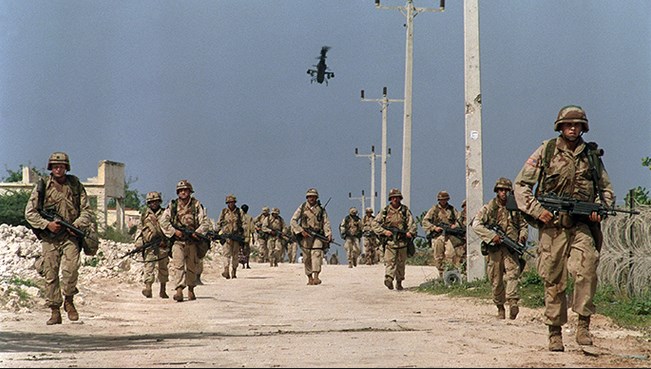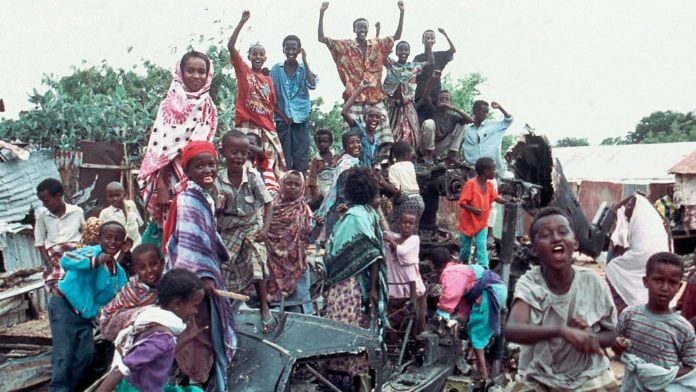U.S. forces hit a peace summit in Somalia, then lied about it. Some say the deadly operation violated the laws of war, but more than 25 years later the cover-up continues.
Christian was nodding off in the back of a Black Hawk helicopter when he heard the first explosion.
“I remember thinking to myself, that was big…it had to be Americans,” he told The Daily Beast. “Nobody else had that kind of firepower in Somalia.”
He’d been orbiting the skies above Mogadishu since 2 a.m. on July 12, 1993, a “pretty uneventful” day for his unit until he saw thick smoke billowing in the near distance. Christian felt more explosions pound his chest. Ten U.S. attack helicopters pumped 16 missiles and over 2,000 rounds of cannon fire into the second floor of a house, the Abdi house, blowing out the stairwell that prevented people from escaping, and then blasting the building apart.
“It blew the whole goddamn building,” said Christian, who requested anonymity even now because aspects of the operation remain classified and he has no authorization to speak about them. “I don’t think whoever ordered that strike could have reasonably expected not to have [civilian] casualties.”
It was 10:18 a.m. and “Operation Michigan” was underway.
 U.S. forces were hunting General Mohammad Aidid, a Somali warlord on whose head the United Nations and the United States had just put a $25,000 bounty. They wanted him arrested on charges he was responsible for the June 5 ambush and killing of 24 Pakistani soldiers assigned to the U.N. Operation in Somalia II (UNOSOM II), a peace enforcement mission involving active combat and nation-building. The midsummer aerial attack, which was lauded as highly successful by the U.S. military, was seen as retaliation for the recent escalating violence. But instead of the Aidid war council they sought, U.S. forces attacked a peace meeting.
U.S. forces were hunting General Mohammad Aidid, a Somali warlord on whose head the United Nations and the United States had just put a $25,000 bounty. They wanted him arrested on charges he was responsible for the June 5 ambush and killing of 24 Pakistani soldiers assigned to the U.N. Operation in Somalia II (UNOSOM II), a peace enforcement mission involving active combat and nation-building. The midsummer aerial attack, which was lauded as highly successful by the U.S. military, was seen as retaliation for the recent escalating violence. But instead of the Aidid war council they sought, U.S. forces attacked a peace meeting.
The disproportionate use of force and the violation of human rights and humanitarian law resulted in overwhelming civilian casualties at a time when the U.N. and U.S. were not at war with Somalia. The Abdi house attack became widely regarded as a symbol of the U.N./U.S. loss of direction in Somalia, from humanitarian champion to mass murderer.
Today, as the Trump administration dramatically steps up its drone strikes in undeclared battlefields that still include Somalia, accountability and legal consequences are still virtually non-existent. There has also been a growing record of U.S. Special Operators under this administration getting themselves and those they work with into dangerous and deadly situations.
The Operation Michigan experience holds vital lessons for the present, but this is the first time someone from the inside has acknowledged it did not hit any of its putative targets and attacked civilians instead, corroborating what journalists, academics, and Somalis have been reporting over the years.
According to the International Committee of the Red Cross (ICRC), Somalia suffered over 200 casualties that day. Following the raid, four Western journalists were stoned to death by an angry Somali mob.
The operation, carried out by the U.S. Quick Reaction Force air and ground elements, became known to Somalis as “Bloody Monday,” a day in which U.S. troops unilaterally conducted an aggressive military operation against Somali citizens, mostly elders meeting to discuss how to pressure Aidid into pursuing peace. Journalists who covered Somalia say the July 12 attack turned Somalis, both civilians and clansmen, against the U.S.
While previous attempts at capturing Aidid were made, July 12 was the bloodiest, solidifying Aidid’s power and heralding a turning point when the hearts and minds on the streets of Somalia were lost.
“That’s the part when we started losing Somalia and didn’t even know it,” said Christian.
After the massacre, clan members took up arms to follow Aidid, creating a larger enemy for U.S. forces to face on October 3, 1993 during the Battle of Mogadishu, the disastrous military mission led by U.S. special forces to capture Aidid that saw two Black Hawk helicopters shot down and the bodies of several U.S. soldiers dragged through the streets on television. The disaster was immortalized in Mark Bowden’s book, Black Hawk Down, and a 2001 movie by the same name.
“There is no question that the raid provoked rage among Aidid’s clan,” said Scott Peterson, the first journalist who arrived on the scene on Bloody Monday and suffered a machete wound to the head after a mob chased him. “There is no doubt that the anger there helped fuel the volcanic violence Somalis showed toward U.S. troops afterwards, most notably during the infamous Black Hawk Down incidents.”
Overshadowed by the journalists’ deaths and by the 18 U.S. soldiers who died three months later, Bloody Monday resembled “mass murder,” according to the 1995 Human Rights Watch report on Somalia. Yet U.S. military officials never investigated the attack or announced a mea culpa.
“The number of dead Somalis never seemed to matter to anyone,” wrote Keith Richburg, a former foreign correspondent for The Washington Post in Mogadishu, in his book Out of America.
A mile and a half away from the carnage unfolding on July 12, chief of the Justice Division of UNOSOM II Ann Wright and staffers ran outside their U.S. compound to high ground after hearing rockets and machine guns firing.
“We knew something bad was happening because of all the noise,” she said. Nobody knew what was going on until they got word that the journalists were killed by Somali crowds, angry about the deaths of their elders, she said. “We started asking questions, like what is going on? Why?”
“The more we heard, the more concerned I was,” she said. A day later, Wright wrote a confidential memo to her boss, the U.N. special envoy to Somalia, U.S. Admiral Jonathan Howe, about how the attack was “nothing less than murder committed in the name of the United Nations.”
Four minutes after the airstrike, U.S. ground troops descended onto the scene to confirm the hit. Then, the radio chatter came in.
Christian remembers early reports from ground troops. “N.E.” he heard them say for “not effective.” Someone asked for clarity over the static. “Target not present. Target not present,” a ground soldier radioed in.
“We had an asset list. Nobody on the asset list was killed or captured that day,” said Christian. “I’ve always felt like there was basically an assassination attempt gone wrong that ultimately led to innocent deaths.”
Following the attack and for years later, Howe and Maj. Gen. Thomas Montgomery, who commanded the U.S. troops in Somalia and was overhead in a helicopter during the operation, have maintained the operation was flawless. They got their targets and didn’t kill any innocent civilians. They disputed the numbers of casualties and insisted it was a war meeting.
According to the after action report on Somalia prepared by Montgomery and others, among those killed were a number of top financiers and military planners, including the overall planner of the June 5 ambush of Pakistani soldiers. Montgomery declined an interview with The Daily Beast.
The official number of casualties by UNOSOM II was 20 (13 dead, seven wounded). But the ICRC reported 54 dead and 161 wounded. Aidid claimed 73 Somalis died, including women and children, and over 200 wounded. U.S. forces suffered no casualties.
Howe told The Daily Beast that Aidid’s Somali National Alliance (SNA) claim was “seemingly exaggerated” and included “some individuals who had died several weeks prior to the raid.”
“There was [also] no evidence of non-combatant casualties from the raid itself,” Howe said.
But Ann Wright, who served 29 years in the U.S. Army and retired as a colonel, said the ground troops didn’t stick around long enough to identify the dead or count them.
“It wasn’t like [the soldiers] went through the wreckage and took out bodies. They just left,” said Wright. The raid was conducted “in lightning speed.”
Christian and his team circled the site over a dozen times, each time, getting a closer look at the “collateral damage” below. Part of his mission meant assessing the threat below him.
“I was looking for threats and I didn’t see any,” he said. What he did see as they touched down to load the ground troops were bodies. Flower print shorts, colorful sarongs, bare feet, sandals, he said.
According to the official version of the attack detailed in the U.N. Blue Book, it took nine minutes for troops to clear the area, search the Abdi house, and depart. And troops left earlier than expected. Christian said his unit was called in closer for backup. The troops barely made it out before the crowds arrived, he said.
Wright and journalists covering the story at the time insist not only were there innocent civilian lives lost but the military planners must have known the meeting would have non-combatants attending.
“They were relying on the information a paid informant gave them that General Aidid would be at the meeting with tribal elders so they knew elders were going to be there,” said Wright.
Sebastian Kaempf, a senior lecturer in peace and conflict studies at the University of Queensland in Australia, wrote about Operation Michigan and interviewed Howe and Montgomery in 2005. He said that U.S. forces must have known about the presence of civilians at such gatherings. Aidid always had a significant civilian presence at meetings; Somali tradition includes women cooking meals and serving tea; and the neighborhood where the attack took place was densely populated.
According to Kaempf, Howe, Montgomery and U.N. military planners knew about the presence of civilians prior to the raid. In a meeting, they decided to drop the advance warning to civilians in the building, an engagement policy that had been normal procedure until the Abdi attack.
Scott Peterson wrote in his book Me Against My Brother that the meeting was publicized a day earlier in the Somali newspapers as a peace gathering.
“There is considerable evidence that it was a hardline war planning session going on at the Abdi center,” Howe told The Daily Beast. “The meeting of clan elders seeking peaceful solutions was several blocks away [from the Abdi house meeting].”
But journalists who interviewed eyewitnesses and saw a video of the aftermath to the attack described the attendees at the Abdi house as religious leaders, former judges, professors, a well-known poet, the clan’s most senior leader in his 90s, younger men, women and children. There were also some hardliners, but all were present to discuss a peace initiative. Survivors of the attack spoke to them about a chaotic scene after the raid in which piles of bloody bodies and body parts blocked their way as survivors struggled to find the stairs to escape in the dark smoke.
In a 1995 interview with Frontline, Montgomery said it was “a very precise and very decisive operation” with the intention of killing “bad guys.”
“As I recall, it went quite well from the standpoint of what we wanted to do at the time. Put the pressure on Aidid, who was acting up,” said Howe. “There’s a huge picture going on during these events. That’s one day, one attack.”
Seventeen minutes after Christian heard the first explosion, the raid was over. Beyond it, the scars remain.
Christian, who lost faith in the overall mission after Operation Michigan and the Battle of Mogadishu, left his career in the military and suffered from PTSD for years after it. Twenty-five years later, Christian said he still thinks about July 12, 1993.
“I saw people get hurt before and we lost men before but everything seemed so pointless there,” he said.
Ann Wright called the attack a “slaughter” and said it violated the Geneva Conventions as published by the U.S. Army in “Field Manual 27-10 Law of Land Warfare” (PDF).
“I was furious…You just blew up a building and you weren’t even sure who was in it?” she said.
In the memo she hand-delivered to Adm. Howe, Wright warned against applying tactical methods usually found in declared wars without a U.N. declaration of war or combat. She also questioned the U.N. Security Council resolution directive authorizing UNOSOM to “to take all necessary measures” against those responsible for the attack on the 24 Pakistani military officers. UNSC Resolution 837 reaffirmed the U.N. Secretary-General’s authority to take all necessary measures, “including to secure the investigation of [those responsible for the armed] actions and their arrest and detention or prosecution, trial and punishment.”
Wright advocated for the opportunity of surrender and detainment and the right to be judged in a neutral court of law. In previous attacks, people were given the option to either stay in the building or exit by broadcasting a warning, she said.
“This is the first incident where no option was given,” she wrote in the memo. The military operation “undercuts U.N. credibility when we can not with accuracy state how many persons were killed or injured, who they were and why they were in the facility.”
Wright said there was little interest at the time in analyzing the legal grounds for such an operation.
“It resonated for one month and then it was swept under the carpet,” she said. “Nobody was held accountable for anything. There should have been an honest investigation into what happened and the chain of command should have been held responsible… It’s kind of the way the U.S. does business now, which is totally wrong.”
She’s not the only one who thought it was wrong. Among journalists who expressed similar sentiments, Aidan Hartley who spoke to survivors and eyewitnesses of the attack said, “Howe and Montgomery have much to answer for but they disappeared from history.”
Thirty minutes after the raid ended, foreign journalists arrived on the scene to report on the aftermath. Four of them were quickly surrounded by an angry Somali mob that chased and beat them to death.
“I said, ‘American in peril,’” Christian recalled. At the time, he and his unit thought all the journalists were American. Their Black Hawk hovered over Reuters photojournalist Dan Eldon, the 22-year-old British-American journalist referred to as “the Mayor of Mogadishu” for the way he won Somalis over with his humor and compassion. In 2017, a movie was made about his life called “Journey Is the Destination.”
“They just kept saying negative, negative. I was confused. I didn’t understand. I couldn’t land the helicopter. I couldn’t say, fuck this, get me down there. There was nothing I could do,” said Christian who watched Eldon get beaten to death as their Black Hawk drummed away.
Christian said he believes he could have saved the journalists: He would have first used smoke to secure the area and then an extraction by helicopter. He had done it so many times before.
At 11:46 a.m., another Black Hawk spotted Eldon. The helicopter landed under cover of a Cobra, dived to scatter the crowd, and recovered Eldon’s body. He was pronounced dead at the U.S. military hospital.
Killed alongside Eldon were German Associated Press photojournalist Hans Kraus, Reuters photojournalist Hos Maina, and Reuters soundman Anthony Macharia, both Kenyans.
“No story is worth this,” Peterson wrote in his book, including Eldon, “the young talent whose ‘Mogged Out’ T-shirt design said the most about the chronic fatigue that all of us experienced covering Somalia.”
For Christian, the image of spotting then abandoning Eldon as he ran for his life only to get beaten to death by Somalis angry at what Christian’s unit had just done to their people is something he can’t forget.
“We were considering people that I previously considered not expendable, expendable,” he said.
































